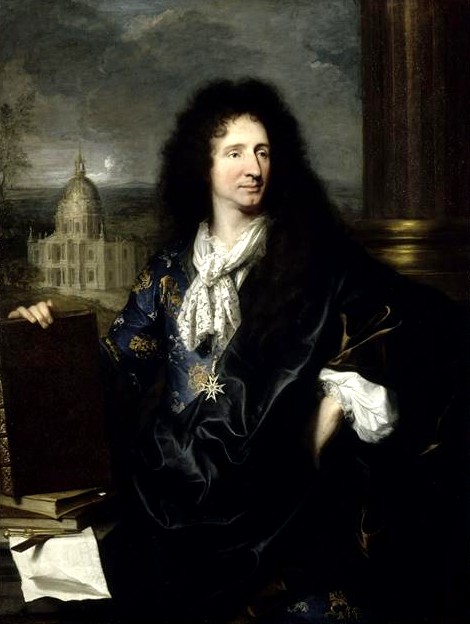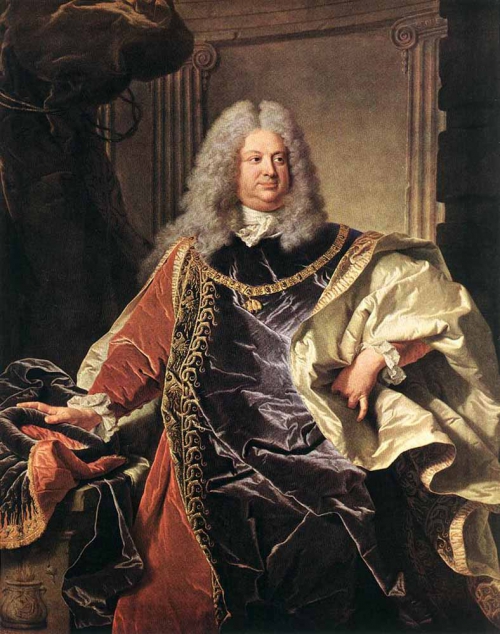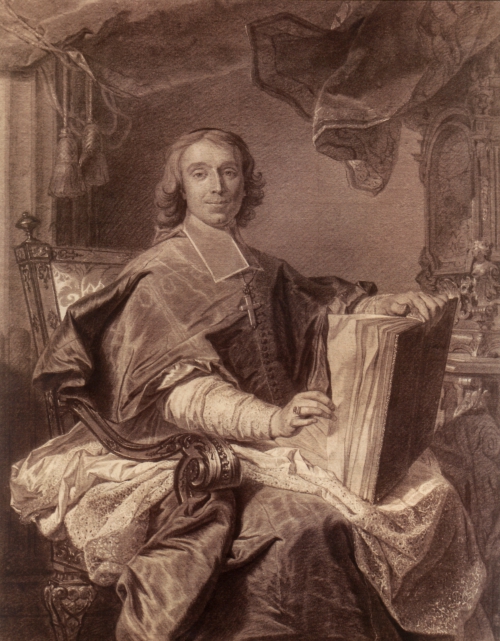Hyacinth Rigaud | XVIIIe | Hyacinthe Rigaud (145 works)
Hyacinthe Francois Honore Rigaud (French Hyacinthe Rigaud; July 20, 1659, Perpignan - December 27, 1743, Paris) - French artist, master of ceremonial Baroque portraits of the times of Louis XIV and Louis XV. A favorite artist of the royal family and aristocracy, in his works, which became the model for European ceremonial portraits of the 18th century, he combined lush theatricality, ostentation with individual characteristics.
Along with N. Largilliere, he was one of the leading portrait painters of the reign of Louis XIV and Louis XV, however, unlike Largilliere, whose clients were mainly representatives of the big bourgeoisie, Rigaud's clientele was predominantly the court aristocracy. At the age of fourteen, Hyacinthe Rigaud came to Montpellier, where he studied for four years with P. Pezet and A. Ranque, then spent four years in Lyon, and in 1681 he entered the Royal Academy of Painting and Sculpture in Paris. In 1682, Hyacinthe Rigaud received the Rome Prize for the painting “Cain Building the City of Enoch,” but on the advice of Charles Lebrun, director of the Academy, he did not go to Italy and devoted himself entirely to the art of portraiture. Initially, Rigo had few orders and modest fees, but thanks to extraordinary hard work and determination, he quickly achieved great success and made a brilliant career. In 1700, Rigaud was accepted as a member of the Academy as a historical painter, although he submitted for consideration as morceau de reception not a historical composition, but a “Portrait of Martin Desjardins” (1692, Paris, Louvre) - court sculptor, rector of the Academy, author of two famous monuments to Louis XIV (one of them for Place de la Victorie in Paris, the other for Place Bellecour in Lyon). During his career, Hyacinthe Rigaud created a huge and impressive portrait gallery of his contemporaries. The artist’s early works were marked by the significant influence of Titian and especially A. Van Dyck, whom he admired (“Portrait of Charles de La Fosse” - 1682, Berlin, Charlottenburg Castle). However, gradually, in the works of Rigaud and his constant rival Largilliere, a special, purely French version of the ceremonial representative portrait was formed, which was dominant in official portraiture until the end of the 18th century. It is noteworthy that recognition and popularity came to Rigo even before he received the title of academician. Already in 1688, Hyacinthe Rigaud painted a portrait of Louis XIV's brother Philippe I, Duke of Orléans, and in 1689 - a portrait of his son Philippe II of Orléans, the future regent of Louis XV. In 1694, Rigaud completed the “Portrait of Louis XIV” (Madrid, Prado), from which over the next seven years the artist’s workshop made 34 copies. In 1700, the artist commissioned Louis XIV to paint a portrait of his grandson Philip V of Spain (Versailles, National Museum of the Palace of Versailles and Trianon), and in 1701 he created his most famous painting, “Portrait of Louis XIV” (Paris, Louvre), which brought him European glory and became a kind of symbol of the era of the reign of the “Sun King”. Hyacinthe Rigaud depicted Louis XIV in full growth against the backdrop of a monumental column and lush draperies. The deliberately pompous composition, the demonstratively theatrical pose of the king leaning on the scepter, and the arrogant expression of his face emphasize the idea of the unlimited power of the monarch. From now on, representatives of many ruling houses in Europe sought to have portraits painted by Rigaud, the main portrait painter of the royal court. They were impressed by the combination of naturalism characteristic of his painting with idealization that ennobles the model’s appearance, but without outright flattery. Already from the late 1680s, as the number of orders increased, the demand for copies of Rigaud’s paintings also increased, while customers were guided in their choice not so much by the high artistic merits of the original as by the social significance of the model. For example, only in 1694 the workshop of Hyacinthe Rigaud completed 37 portraits and 80 copies. Such a grand scale work could have been carried out by the efforts of a large team of painters of various profiles. Therefore, Rigaud collaborated not only with portrait painters, but also with landscape painters, battle painters, and still life painters (J. B. Belin, Delaunay, F. Deporte, J. Legros, A. Monnoyer, J. Parrocel, S. de La Penne, B. de Fontenay, P. N. Huyo), who painted the background, clothing, accessories or a completely human figure, with the exception of the face and hands, which were the prerogative of Rigaud himself. In the artist’s studio, there was a practice when executing new orders to take as a model compositions, poses, costumes and surroundings that were previously used in other paintings. Such portraits were much cheaper than the “original” ones. Hyacinthe Rigaud's commissioned portraits are characterized by virtuoso skill in conveying an external resemblance to the model, pomp and social elegance, which perfectly met the tastes of the royal court and foreign
customers. In such portraits, Rigaud was interested not so much in the inner world of a person, but in a detailed description of the situation, attributes of power, allegorical details, as well as optical illusionism in the interpretation of elegant costumes and precious jewelry. Rigaud's artistic style is characterized by a confident and energetic brushwork, meticulous detailing and decorative colorfulness. At the same time, in a number of commissioned portraits, the artist showed himself not only as a subtle physiognomist, but also as an observant psychologist. Among such works is, in particular, “Portrait of Fontenelle” (Moscow, Pushkin Museum) - a famous writer, philosopher, scientist, member of the French Academy. In this portrait, Hyacinthe Rigaud abandoned the idealization of the model and lush accessories. The painting shows an elderly man with a thin face, a high open forehead and an expressive gaze. By depicting Fontenelle in modest home clothes against a strict neutral background, Rigaud managed to convey the lively sparkle of his penetrating eyes and subtle ironic mind with laconic means. The objectivity, naturalness, simplicity and intimacy inherent in such portraits are characteristic features of French chamber portraits of the 18th century. Rigaud's late portraits are marked by the influence of pastoral trends. These are the “Portrait of Marguerite Le Bret de la Brief”, presented in the form of Ceres with a sickle and a bunch of ears of corn in her hands (private collection, engraved in 1728 by P. Dreve), and “Portrait of Pierre de Gueydan”, depicted in peasant clothes with bagpipes in hands (1719, Aix-en-Provence, Granet Museum). It is noteworthy that male portraits predominate in the work of Hyacinthe Rigaud. Avoiding painting portraits of women, the artist explained this as follows: “If I make them as they really are, they will not find themselves beautiful enough. If I flatter them too much, they won’t be alike.” The wide spread of the artist's fame was greatly facilitated by graphic reproductions of his paintings, which were created by the best engravers of the era (P. Drewe, G. Duchange, J. Edelink), and most often engraved images of officials, as well as writers for the title pages of books. In 1710, Rigo became a professor at the Royal Academy, in 1716 his “Self-Portrait” adorned the famous gallery of portraits of artists of the Duke of Tuscany Cosimo III Medici (Florence, Uffizi), in 1727 he received the Order of St. Michael along with the royal pension, and in 1733 - position of director of the Academy. In addition to Rigaud's paintings, his drawings, made in black or white chalk on light blue paper, have also been preserved. These sheets represent either preparatory studies for future paintings, or careful copies of already completed works, intended for engravers as models.
Works: “Portrait of Pierre Mignard” (1691, Versailles, National Museum of the Palace of Versailles and Trianon); “Portrait of Prince Frederick of Denmark” (1693, Copenhagen, State Art Museum); “Portrait of Marie Serre, the artist’s mother” (1695, Paris, Louvre); “Portrait of Jacques Bénigne Bossuet” (1702, Paris, Louvre); “Portrait of Cardinal de Bouillon” (1708, Perpignan, Rigaud Museum); "Portrait of the Duke d'Antin" (1709, Versailles, National Museum of the Palace of Versailles and Trianon); “Portrait of Elizabeth Charlotte, Duchess of Orleans” (1713, Brunswick, Duke Anton Ulrich Museum); “Portrait of Fontenelle” (1713, Montpellier, Fabre Museum); “Portrait of Prince Augustus of Saxony” (1715, Dresden, Picture Gallery); “Portrait of the Swedish King Charles XII” (1715, Stockholm, National Museum); “Portrait of Louis XV in royal garb at the age of five” (1716, Versailles, National Museum of the Palace of Versailles and Trianon); “Portrait of the Duchess of Orleans, Princess of the Palatine” (1718, Geneva, Museum of Art and History); “Portrait of Samuel Bernard” (1726, Versailles, National Museum of the Palace of Versailles and Trianon); “Portrait of a Scientist” (St. Petersburg, State Hermitage Museum).






































